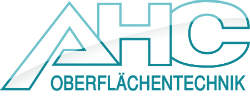
The corrosion and wear protection of seat rails for aircraft made from a high-strength aluminium alloy is improved by a special coating process from AHC Oberflächentechnik.
The firmly anchored, standardised seat rail is the interface between the seats and the aircraft. In today’s serial production of seat rails, the profiles are initially anodised conventionally. They then receive a primer (containing Cr6+) and a topcoat, each as a spray application. In practice, improved corrosion and wear protection are often desirable.
This has the following advantages:
- The maintenance intervals can be extended
- Aluminium rails can also be used in wet areas where titanium alloys have been used until now
- The rails have sufficient abrasion resistance which is required due to moving the seats
- In addition, the seat movement on the rail can be made easier
These advantages are provided by a coating on the seat rails with AHC’s special, hot-water sealed variant of the hard anodising process HART-COAT®-P (HC-P), with a layer thickness of approx. 35 μm.
HART COAT®, HC for short, is a hard anodised surface finishing for aluminium materials, also known as hard coating. It serves primarily to protect aluminium components from corrosion, wear and high temperature loads. The aluminium workpiece is connected as an anode to a current source and is suspended in a coating bath filled with electrolyte fluid. The cathode is located at the edge of the bath. Through the influence of the electric current, the surface layer is formed due to the conversion of the original aluminium surface into aluminium oxide but not by external material application. This oxide layer grows on the surface of the base material with the transformation in approximately equal parts internally and externally, whereby an increase in volume takes place.
The HART-COAT® variant (HC-P) used to protect seat rails in aircraft is used with defined electrical values. In long test runs, good results for corrosion-protection and abrasion-resistance have been shown. The corrosion-resistance amounts to approx. 1,000h according to DIN EN ISO (salt spray test). Abrasion-resistance is significantly improved since the coating is not a lacquer based solution. The fatigue strength is only reduced by up to 3% in comparison to an uncoated component.
The seats are secured to the seat rail by so-called ‘front studs’ and ‘rear fittings’. Additionally coating these parts with PTFE-DURNI-DISP, noticeably increases the mobility of the seat adjustment. PTFE-DURNI-DISP is an electroless nickel coating with embedded PTFE particles, another coating process from AHC. In this coating process, nickel-phosphorus alloy layers are firmly deposited on surfaces. The coating process is carried out in an aqueous electrolyte with dissolved nickel ions. A reducing agent provides the phosphorus which is uniformly incorporated into the nickel layer. The alloy deposition is based on a chemical reaction and therefore no external current source is required. Unlike a galvanic coating, this electroless process allows a true-to-contour reproduction of the surface with a uniform layer thickness. The PTFE-DURNI-DISP process used in the situation described is a variant of the coating process. Here, solid polytetrafluoroethylene (PTFE) is homogeneously distributed and incorporated into the electroless nickel layer.
The PTFE-DURNI-DISP layer combines the properties of the nickel layer deposited without the use of a current, with those of the PTFE: wear resistance is combined with anti-friction properties and the tribological properties of the surface are significantly improved.
The coating solutions used not only fulfil the requirements of the seat rail manufacturers, but they also increase passenger comfort.










